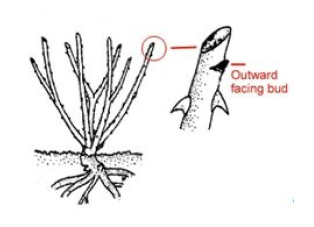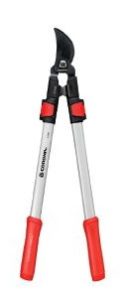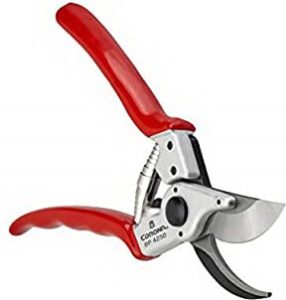February 2022, Frank Brines
Rose Care FUNdamentals – Feb. 2022

Frank Brines
ARS Master Rosarian
In southern California winter is usually short and sometimes confusing. Winter for some plant life is a time of withdrawal that precedes renewal. For roses it is necessary to help them in that process. Now is the time to perform a few procedures to help reset their hormonal clock and get them ready for a great year of rose blooms. That’s the main purpose for pruning.
According to experienced rosarians, the proper time for the major annual pruning is “late winter.” This has many meanings in an area like So Cal which has numerous weather zones. Bottom line: Prune late enough to avoid risking frost damage to the tender growth that will emerge as a result of pruning. After this pruning, you can usually expect a flush of blooms 8 to 12 weeks later, depending on the temperatures during that period: the warmer it is, the shorter the time to blooms. But all things being equal, if you prune in the latter half of February you will likely have blooms in mid- to late‑April. If you want blooms for a specific date, count backwards approximately 10 weeks from that date. Pruning should be complete on this date.
In most of our region the last average frost date is mid‑March, so that means you’re probably safe pruning in mid- to late‑February. It is always a gamble and the best advice is to watch the weather. If there is winter rain during January or February, pruning can be held off awhile since these rains are cold, making the ground colder and wetter than usual.
If you haven’t began or finished pruning by now, don’t fear. There is still plenty of time to have blooms for rose shows or special spring events!
Classes of Roses
Different classes of roses benefit from different styles of pruning. To discover the class of a rose you’re working on, go to https://www.helpmefind.com/rose/plants.php and type all or part of the rose’s name to get links that best match your rose. In that information will be its class. This month’s column presents pruning techniques that work well for the first five classes described below. They are not really applicable to climbers, ground cover roses, or shrub roses: all those types have their own pruning methods.
- Hybrid Tea Roses (HT): You can think of these as “florist roses.” Their buds are usually borne on long stems with elegant high centers before opening, and 30 to 50 petals. If blooms are consistently removed, most hybrid teas will produce a new “flush” of blooms every six to eight weeks.
- Floribunda Roses (Fl): Large clusters of flowers and generally in continuous bloom through the growing season. They require less care and offer practically a hands-free experience.
- Grandiflora Roses (Gr): A subclass of hybrid teas but with floribunda features. They have elegant showy clusters of three to five blooms with nearly hybrid tea form and a constant growth cycle like floribundas. They tend to be larger and taller than hybrid teas.
- Polyantha Roses (Pol): Like floribundas but much shorter and with smaller, prolific blooms. They work well for edgings and hedges, and can be easily grown in pots. They are generally low-maintenance and relatively disease-resistant.
- Miniature Roses (Min): These have hybrid tea or grandiflora forms but are typically shorter and a bit more compact. Miniature roses can grow anywhere between 15 to 30 inches, whereas mini-flora roses tend to be intermediate-sized blooms closer to the size of a floribunda.
- Shrub Roses: These tend to sprawl from 5 to 15 feet in every direction, producing abundant clusters of blossoms. There are many subcategories, including the “David Austin English Roses.” Note: To prune shrub roses, cut them back to conform to the space you want them to fill, inspect and clean out dead and diseased material from the center, shorten canes and remove about one third of the growth.
- Groundcover Roses: Also called “landscape” roses, these are low‑maintenance and well suited as space fillers. They sprawl outward but reach no more than three feet tall, are generally disease‑ and pest-resistant, and bloom continuously.
- Climbing Roses: These are not a class, but more of a description, that is, there are grandiflora or floribunda climbing roses. They can’t actually “climb” like vines, but they produce long, sturdy, upright and sometimes arching canes which can grow up to 15 feet, going beyond a trellis, fences, arbors or pergolas. They tend to produce more flowers when grown horizontally rather than vertically.
Getting Your Tools Ready
Before you prune, get your equipment in good order. Ideally, you will have gloves with arm protectors, a long handle lopper, a hand-held pruning saw, and a pair of sharp clean “bypass” hand pruners. The standard hand pruner is good for one‑inch diameter cane, the loppers and saw for anything thicker. (Using too small a pruner on too large a cane can damage the cane and “spring” the pruner so it doesn’t produce a clean cut.)
Bypass Pruners
What does “bypass” mean? Compare your pruners to the image shown above: Bypass pruners have a sharp cutting blade (which slices through the cane) and a dull curved non‑cutting blade (which holds the cane in place during the cut). The sharp blade “by passes”, or over shoots, the dull curved blade. This is in contrast to an “anvil” pruner which has a straight blade that comes down on a straight bar.
Follow these steps to get your tools ready:
- Lubricate the moving parts with a little light oil (such as 3-in-1 oil), and make sure they operate without resistance.
- Clean all tools with rubbing alcohol before and during the job. It helps prevent transmitting diseases from plant to plant and you can use it as first aid for punctures and scratches to your skin.
- Sharpen each blade with a small diamond file (available at garden centers), trying as much as possible to match the original bevel of the blade. Every 100 cuts or so, swipe the file over the blade a few times to keep it sharp. If you notice that your pruners are crushing the stems and/or leaving a “tail” (a small strip of tissue sticking up from the cut) then it’s past time to sharpen them!
Gross Pruning
For all cuts, orient your pruners or lopper so that the non‑cutting blade is in contact with the portion of the cane that will be removed, and the cutting blade is on the side of the cut that will remain on the plant. (See “Blade Orientation” below right.) This will make more sense when you are actually holding the pruners and getting ready to cut!
A word of caution when gross pruning: Look for the small nests of hummingbirds, as this is the nesting period for two varieties in our area. Also, if you discover praying mantis egg cases on any branches you remove, find a place to put them where they will be undisturbed and hatch out so you can benefit from the offspring!
- In Southern California our rose bushes can grow quite large, so start with some gross pruning to bring the project down to size. I use loppers to cut every bush down to about 3 – 4 feet high.

- Next, remove all the leaves from the plant and discard into green waste bin. This removes diseased material and helps you see the structure clearly.
- Use your hand pruners or loppers to remove canes that are twiggy, dead, crossing other canes, or passing through the center of the plant.
Fine Pruning
After removing all that stuff from the interior of the bush, you’re ready to do your fine pruning. Apply these guidelines:
- Prune each cane down to a height you feel comfortable with, likely between 12″ and 24″ tall. (See “Pruning Styles” image below.)
- When pruning a cane, make an angled cut about half an inch above an outward facing bud. (See “Outward Facing Bud” image below.) This ensures that the stem grows away from the center of the plant. Note that there are always one to three buds wherever a leaf met the cane; outward-facing buds tend to be about 4″ apart. If you prune lightly to moderately—that is, if you keep your canes a little longer rather than shorter—and if frost damages the tender young growth, then you can still re‑prune to the next bud down.
- Attempt to end up with a domed top to the degree possible so the plant will bush out in a pleasing, balanced manner.


Clean and Feed
- Clean the ground thoroughly of all rose debris and dispose of all cuttings and other materials in your green waste bin and put it on the street: Do not compost it!
- Asses the irrigation system for any needed repairs while there is no new growth and mulch has not been spread.
- Apply a dormant spray to the plants and the soil surface to ward off diseases. Then apply 2″ to 4″ of composted mulch to cover the entire garden area.
- The first fertilizing will be when new growth is about 2 inches long. I recommend lower values of the three elements (Nitrogen [3], Phosphate [4],K Potassium [3]) with slightly higher value for Phosphate.
- Two weeks later, begin with heavier feeding every 2 weeks for great blooms or at least monthly.

Frank Brines
ARS Master Rosarian
I am an ARS Master Rosarian. If you would like personal answers to rose questions you can leave them on the TVRS website or email me at roseguy2000@aol.com.




